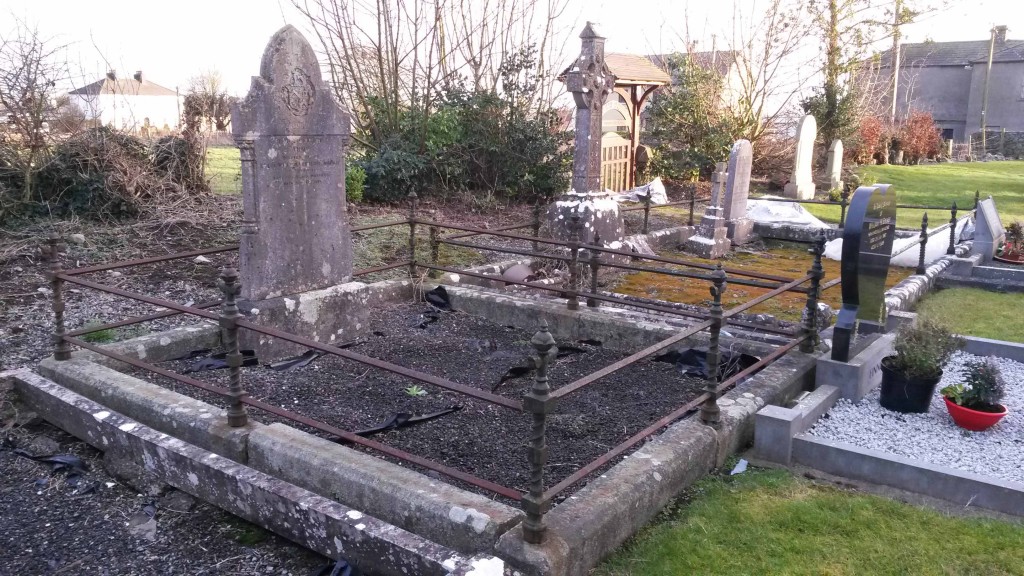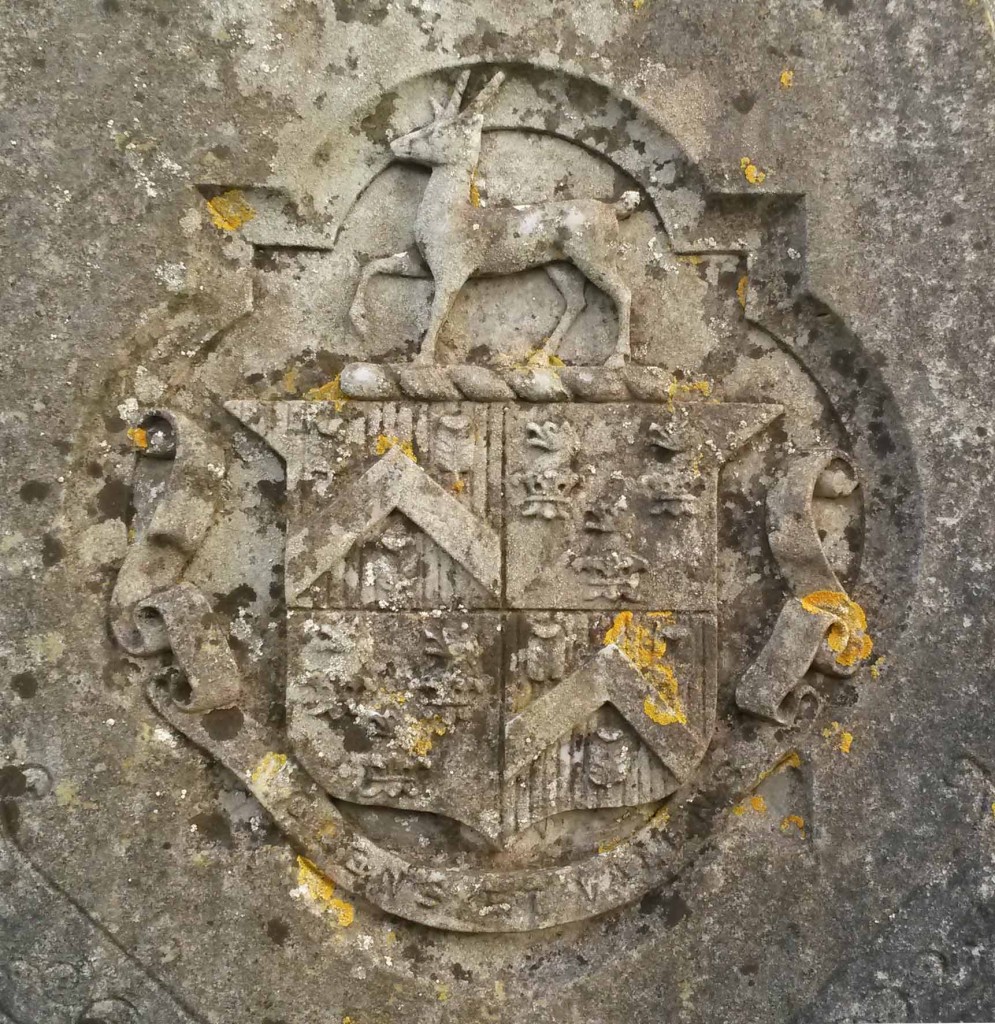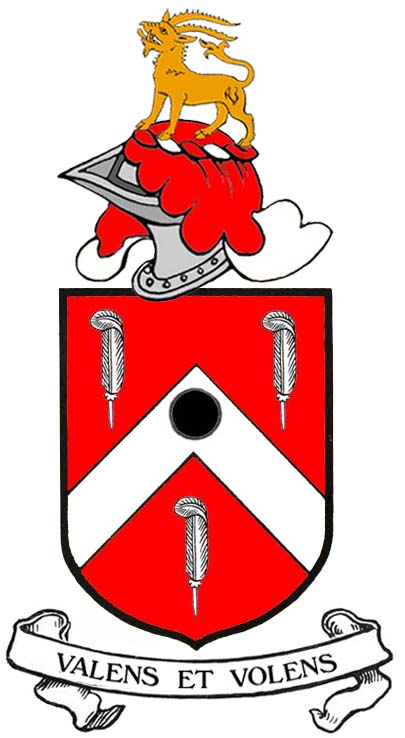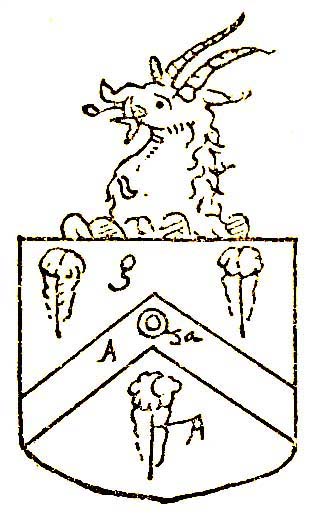© Donal G. Burke 2015
In the mid seventeenth century significant lands stretching along the western side of the River Shannon from about Portumna to the parish of Clonfert were confiscated from various landholders such as the Earl of Clanricarde, O Maddens of Lismore and of Derryhiveny, O Horans, O Cormicans and others and granted by the Cromwellian authorities to Henry, son of Oliver Cromwell.[i]
Following the turbulent changes in land ownership of the Cromwellian period and the restoration of the monarchy in the person of King Charles II in 1660, an Act of Settlement was passed in Parliament, in an attempt to address the complaints of those whose lands had been taken or divided by the Cromwellians and to placate those who had acquired lands at that time.
Under the Act, Henry Cromwell retained a large part of his Irish estates along the Shannon and while some, such as the Earls of Clanricarde, regained their estates, other such as the O Cormicans and the O Maddens of Derryhiveny in the parish of Kilmalinoge failed to regain ownership of their former lands. Cromwell sold his Irish lands, which were purchased thereafter by the Earls of Cork and Arran.[ii]
These lands were subsequently sold by Lady Burlington and Cork in 1717 to a London merchant, Benjamin Gascoigne.[iii] The lands about Kilmalinoge were sold in 1749 to one Theobald Wolfe, through the marriage of whose daughter those lands came into the possession of the Fetherstonhaugh family. The Fetherstonhaughs leased part of these lands to others but at one time were also seated about the former O Madden estate at Derryhiveny.[iv]
The foremost Fetherstonhaugh family in Ireland descended from Cuthbert, son of Ralph Fetherstonhaugh of either Hetherege or Heathery, County Durham and Castle Warden in Cumberland, who settled in Phillipstown in 1651 and died in 1693 at the age of seventy-two years. The branch settled at Derryhiveny descended from John of Dardistown, who died in 1776, eldest son of Cuthbert of Dardistown who died in 1744, second son of John of Castlekeeran, County Meath and Rath, County Westmeath, eldest son of the first Cuthbert of Phillipstown. John Fetherstonhaugh of Dardistown who died in 1776 had at least two sons, the eldest of whom was Cuthbert of Mosstown, County Westmeath, High Sheriff of 1781. It was this Cuthbert of Mosstown who married in 1770 Mary, elder daughter and co-heiress of Theobald Wolfe, B.L., of Newtown, County Dublin and through whose marriage the family acquired the property about Kilmalinoge. By his wife he had four sons; Theobald of Mosstown, Rev. Cuthbert, Edward and William. The youngest son, William, married Anne, daughter of one R. Welsh and had at least one son, William Andrew Fetherstonhaugh and one daughter Anne.[v] As Anne was described as the only daughter of William of Derrahiney and wife of John Walter Henry Lambert of Aggard, it would suggest that William’s was the first generation to settle at Derryhiveny.[vi]
In 1848 William Andrew Fetherstonhaugh ‘of Derrahivny’ married his cousin Anne, daughter of his eldest uncle Theobald Fetherstonhaugh of Mosstown. (Through this marriage the Fetherstonhaugh line of Derryhiveny was doubly connected with Kilmalinoge as William Andrew’s wife’s mother was Mary, daughter of Jonathan Harding of Harding Grove in the townland of Derryhiveny North.) He pursued a military career and attained the rank of Lieutenant Colonel of the 14th King’s Hussars. By his wife he had an only child, a daughter and heiress, Alice Emily, who would later marry Charles Wray Thompson Esq., a Magistrate for County Dublin, second son of Thomas Thompson Esq., J.P. and D.L., of Holywoodrath, County Dublin and through this marriage, after the death of her father in 1888, the Derryhiveny or Derrahiney estate passed to the Thompson family.[vii]
On the death of Lieutenant Colonel William Andrew Fetherstonhaugh’s wife in September 1881 a headstone was erected over her grave at the Protestant Church of Ireland church of St. John the Baptist in the nearby village of Eyrecourt, bearing the quartered and undifferenced arms of her husband. While the arms were shown untinctured the shield appears to have been blazoned; quarterly, first and fourth, Gules, a chevron between three ostrich feathers Argent (for Fetherstonhaugh); second and third, Argent, three wolves heads erased ducally gorged Or. (for Wolfe). The shield shown thus quartered indicated his descent from his grandmother, the co-heiress of Theobald Wolfe of Newtown.
The Church of St. John the Baptist, built in the late 1860s on Church Lane in Eyrecourt to serve the Protestant Church of Ireland congregation.
The grave of Anne, wife of Lieutenant Colonel William A. Fetherstonhaugh ‘of Derrahiney’, in the foreground, located on the east side of the Church of St. John the Baptist, Eyrecourt.
The quartered arms of Lieutenant Colonel William A. Fetherstonhaugh of Derrahiney, as carved upon the headstone at the Church of St. John the Baptist, Eyrecourt, commemorating the death of his wife Anne, bearing the motto ‘Volens et Valens.’
The crest carved at Eyrecourt was that of an antelope passant, the same stance given in ‘Burke’s Irish Family Records’ of 1976 in the crest of their kinsmen, the families of Bracklyn Castle, Dardistown, Mosstown, Rockview, Newtown, Carrick and Killua Castle, all of County Westmeath. That source gives the tinctures of the antelope passant as Argent armed Or, while a nineteenth century source gave the crest of Bracklyn Castle, Carrick and Rockview as an antelope statant armed Or. The former tinctures and stance appear to have been those used by the Derryhiveny family as evidenced by a confirmation of arms made in the mid twentieth century to another of the wider family, another descendant of the Fetherstonhaugh Wolfe marriage.
Alfred Hardinge Fetherstonhaugh, then resident at Glenbrook, County Cork, Esquire (later of ‘Kenyam, Strawhill, Monkstown, County Cork’) applied to the Office of Arms in Dublin for a confirmation of arms ‘long used and borne by his family. The applicant was fourth but only surviving son of Richard Henderson Fetherstonhaugh of Blackrock, County Cork, second son of Theobald of Newtown, County Westmeath, the third son of Theobald of Mosstown by his wife Mary Harding of Harding Grove, eldest son of Cuthbert of Mosstown by his wife Mary Wolfe. As such, like his kinsmen of Derryhiveny, his arms and those of his immediate branch reflected their descent from the Wolfe heiress. The arms confirmed by Edward MacLysaght, ‘Principal Herald of Ireland’ in May of 1946 unto Alfred Hardinge Fetherstonhaugh and the other descendants of his grandfather Theobald of Newtown, each using their ‘due and proper differences according to the Laws of Arms,’ were blazoned ‘Quarterly, first and fourth Gules, a chevron between three ostrich feathers Argent (for Fetherstonhaugh), second and third, Argent, three wolves heads erased sable ducally gorged Or (for Wolfe) and for crest; an antelope passant Argent armed Or and for motto; Valens et Volens.’[viii] The arms confirmed on this occasion, with the exception of the relevant ‘due and proper differences’, would appear to have been identical to those used by the line of Derryhiveny.
The family of Fetherstonhaugh of Bracklyn Castle, Co. Westmeath shared a common descent with the family of Derryhiveny, barony of Longford, Co. Galway from Cuthbert Fetherstonhaugh, the first of the name to settle at Dardistown and who died in 1744, grandson of that Cuthbert who was the first of the family to settle in Ireland in the mid seventeenth century. The arms of Fetherstonhaugh of Bracklyn Castle was given in the mid Nineteenth Century as ‘Gules on a chevron between three ostrich feathers Argent, a pellet.’ For crest he bore an antelope statant, armed Or and for motto ‘Valens et Volens.’[ix] The feather and pellet charges, with the latter’s similarity to a stone, may have served as a reference to the composition of the family name, although the pellet is not always given in the arms of all of the name and did not appear on the arms above the Eyrecourt grave of Anne Fetherstonhaugh. In a number of other cases of armigers of the name, however, similar charges such as annulets Sable or voided pellets were also used.
Arms of James Howard Fetherstonhaugh of Bracklyn Castle, County Westmeath, born in 1819, as described in the 1862 edition of Burke’s Genealogical and Heraldic Dictionary of the Landed Gentry of Great Britain and Ireland. The same arms were described for the families of Carrick and Rockview.
A more senior line than that of Derryhiveny, Mosstown or Bracklyn descended from the first Cuthbert in Ireland was that seated at Ardagh, Edgeworthstown in County Longford. This line of the family used the form Fetherston as their surname as opposed to Fetherstonhaugh. Ralph, fourth son of Thomas of Ardagh, County Longford, eldest son of John of Castlekeeran and Rath, eldest son of Cuthbert Fetherstonhaugh of Phillipstown served as Member of Parliament for Longford from 1765 to 1768 and for Johnstown from 1768 to 1780. In 1776 he was created a Baronet of Ireland by King George III. About the early years of the twentieth century his descendant the Reverend Sir George Ralph Fetherston ‘of Ardagh in the County of Longford, Baronet, Clerk in Holy Orders, one of His Majesty’s Justices of the Peace for the said county and High Sheriff there for the year One Thousand Eight Hundred and Ninety Seven,’ applied to the Ulster King of Arms to have the arms used by his predecessors officially confirmed as theirs by right. Sir Ralph Fetherston, the first baronet, neglected to register his arms when he was created a baronet and as a consequence Rev. Sir George R. Fetherston, 6th Baronet, applied for a ‘full confirmation of his arms with such distinction as may be assigned unto him and his descendants and the other descendants of his great great grandfather’ the first baronet. The arms confirmed in 1907 were blazoned ‘Gules, on a chevron between three ostrich feathers Argent, an ogress, for crest, on a wreath of the colours, an antelope statant Argent, armed Or and for motto ‘Volens et Valens.’[x] The baronetcy became extinct on the death in 1923 of the sixth baronet.
The shield, crest and motto of Rev. Sir George Ralph Fetherston, 6th Baronet, of Ardagh, County Longford, confirmed in 1907 unto him, his descendants and the descendants of his great great grandfather Sir Ralph Fetherston, 1st Baronet. The form of the antelope exemplified in the contemporary records of the office of the Ulster King of Arms (NLI, Dublin, G.O. Ms. 111,Grants and Confirmations of Arms, Volume J, 1898-1909, fol. 198) was that of the animal as it appears in nature, rather than the heraldic antelope depicted above. It became the practice in the modern period to depict the antelope in heraldry in its natural form and it thus appears on the Fetherstonhaugh stone at Eyrecourt and in the exemplification of the arms confirmed unto Alfred Hardinge Fetherstonhaugh in 1946. In late Medieval and certain Early Modern sources the antelope appears as a mythical creature, incorporating in its form elements such as the body of a stag, a long tail, a tusk and tufts along the body.
One of the earliest of the name recorded as bearing arms would appear to be William Fetheir, who, in a Roll of Arms dating from the reign of King Edward II, bore ‘Gules, a chevron Ermine between three plumes (ie. feathers) Argent. Jenyns Ordinary (Harl. Ms. 6589) gave a single ermine spot on the chevron. Several centuries later, in an heraldic visitation of the Northern Counties ‘conteyninge the Armes or Cote Armers of the Nobylite and Gentyllmen frome Trent northeward’ undertaken in 1558 by Sir Marmaduke Constable, knight, gave the arms of a family of Fetherstonhaugh as ‘Gules, a chevron between three ostrich feathers Argent.’ A Roll of Arms from the reign of Queen Elizabeth I gave the same arms as those of one John Fetherstonhaugh of Stanhop, Esquire. In the visitation of Cumberland undertaken in 1666 the same shield again was given as part of the achievement of Thomas Fetherston of Kirk-Oswald, son of Sir Timothy Fetherston, knight ‘put to death at Chester by the usurping power of Cromwell, anno 1653.’ The latter family’s crest in that visitation was given as ‘an antelope’s head Gules, crined and armed Or.’[xi]
A charged chevron formed part of the arms of two families of Fetherston whose pedigrees and arms were recorded in heraldic Visitations in England in the late seventeenth century. Alexander Fetherston, Rector of Wallesey in Wyrhall, Prebend of Celwich in Lichfield Cathedral and Minister of St. John’s in Chester was aged forty-six years at the time that the 1663 Visitation of Staffordshire was undertaken. The son of Christopher, Rector of Bentham in Yorkshire, who died in 1653, a younger son of Alexander Fetherston of Fetherstonhaugh in Northumberland, his arms were shown tricked as Gules on a chevron between three ostrich feathers Argent an annulet Sable at centrepoint and for crest an antelopes head, apparently erased. The 1615 Visitation of Northumberland gives this Alexander as son of Anthony but renders the surname ‘Fetherstonehalghe of Fetherstonehalghe.’
The tricked arms of Alexander Fetherston, Rector of Wallesey in Wyrhall from the 1663 Visitation of Staffordshire, descended of a junior line of the Fetherstonhaugh family of Fetherstonhaugh in Northumberland. While an annulet is used as a mark of cadency to indicate a fifth son, its use in this case appears to be that of differentiation from other families of the name, as the armiger was the only son recorded of his father Christopher, who in turn was given as second son of Alexander of Fetherstonhaugh in the Staffordshire Visitation and third son in the earlier Nothumberland Visitation.
A chevron charged also appears in the arms of a family of Fetherston in Warwickshire, the senior lines of which were represented in the 1682 Visitation of that shire by Thomas of Packwood in Warwickshire, born in 1633 and William of the City of Coventry, born in 1640, third and fourth sons of John Fetherston of Packwood, Barrister at Law, but the senior-most surviving after the deaths of their elder brothers in 1646 and 1647. Their father John of Packwood was in turn eldest son of another John of Packwood. The family arms were recorded tricked as Gules on a chevron between three ostrich feathers Argent three annulets Sable. No crest was indicated in the visitation records for this family.
[i] MacGiolla Choille, B. (ed.), Books of Survey and Distribution, Vol. III, County of Galway, Dublin, Stationary Office for the I.M.C., 1962, pp. xlvii, 180-2; Simington, R.C., The Transplantation to Connacht 1654-58, Shannon, Irish University Press, for the I.M.C., 1970, p. 161.
[ii] MacGiolla Choille, B. (ed.), Books of Survey and Distribution, Vol. III, County of Galway, Dublin, Stationary Office for the I.M.C., 1962, pp. xlvii, 180-2.
[iii] Melvin, P., Estates and Landed Society in Galway, Dublin, Edmund Burke Publisher, 2012, pp. 47, 64.
[iv] Melvin, P., Estates and Landed Society in Galway, Dublin, Edmund Burke Publisher, 2012, pp. 47, 64.
[v] Montgomery-Massingbred, H. (ed.), Burke’s Irish Family Records, Burkes Peerage Ltd., London, 1976, pp. 406-410, 1222.
[vi] Burke, B., A Genealogical and Heraldic Dictionary of the Landed Gentry of Great Britain and Ireland, Vol. I, London, Harrison, 1862, p. 472-3.
[vii] Walford’s The County Families of the United Kingdom, 49th Edition, Spottiswoode & Co. Ltd., London, 1909, p. 1080.
[viii] NLI, Dublin, G.O. Ms. 111G, Grants and Confirmations of Arms, Vol. Q, 1943-1956, fol. 30.
[ix] Burke’s Landed Gentry of Ireland, 1912, p. 388.
[x] NLI, Dublin, G.O. Ms. 111, Grants and Confirmations of Arms, Vol. J, 1898-1909, fol. 198.
[xi] Foster J., Some Feudal Coat of Arms, James Parker & Co., Oxford and London, 1902, p. 86; Publications of the Surtees Society, Vol. XLI, 1862, Heraldic Visitation of the Northern Counties in 1530 by Thomas Tonge, Norroy King of Arms, edited by W. Hylton Dyer Longstaffe, Whittaker & Co., London, 1863, Appendix, pp. xv, xvii, lxxvi; Foster, J. (ed.), Pedigrees recorded at the Herald’s Visitation of the Counties of Cumberland and Westmoreland made by Richard St. George, Norroy King of Arms in 1615 and William Dugdale, Norroy King of Arms in 1666, Carlisle, Charles Thurnam & Sons, p. 45.







